Starbucks Case Study: Growth Initiatives, Brand Positioning Analysis
VerifiedAdded on 2023/04/11
|7
|1008
|329
Case Study
AI Summary
This case study examines Starbucks' initial target market, brand positioning, and growth strategies under Howard Schultz. It explores how Starbucks aimed to create a 'third place' for consumers by offering premium coffee and experiences. The company's aggressive growth initiatives, including international expansion, new product introductions like Frappuccino, and strategic partnerships, are analyzed. The study evaluates the success of these initiatives, highlighting how some decisions, like employee training and strategic locations, positively impacted the brand. However, it also discusses how rapid expansion and the introduction of drive-thrus led to a commoditization of the Starbucks experience, diluting its original brand positioning. The case concludes by reflecting on the balance between growth and maintaining brand integrity.

NAME: ______________________________
Paraphrase This Document
Need a fresh take? Get an instant paraphrase of this document with our AI Paraphraser
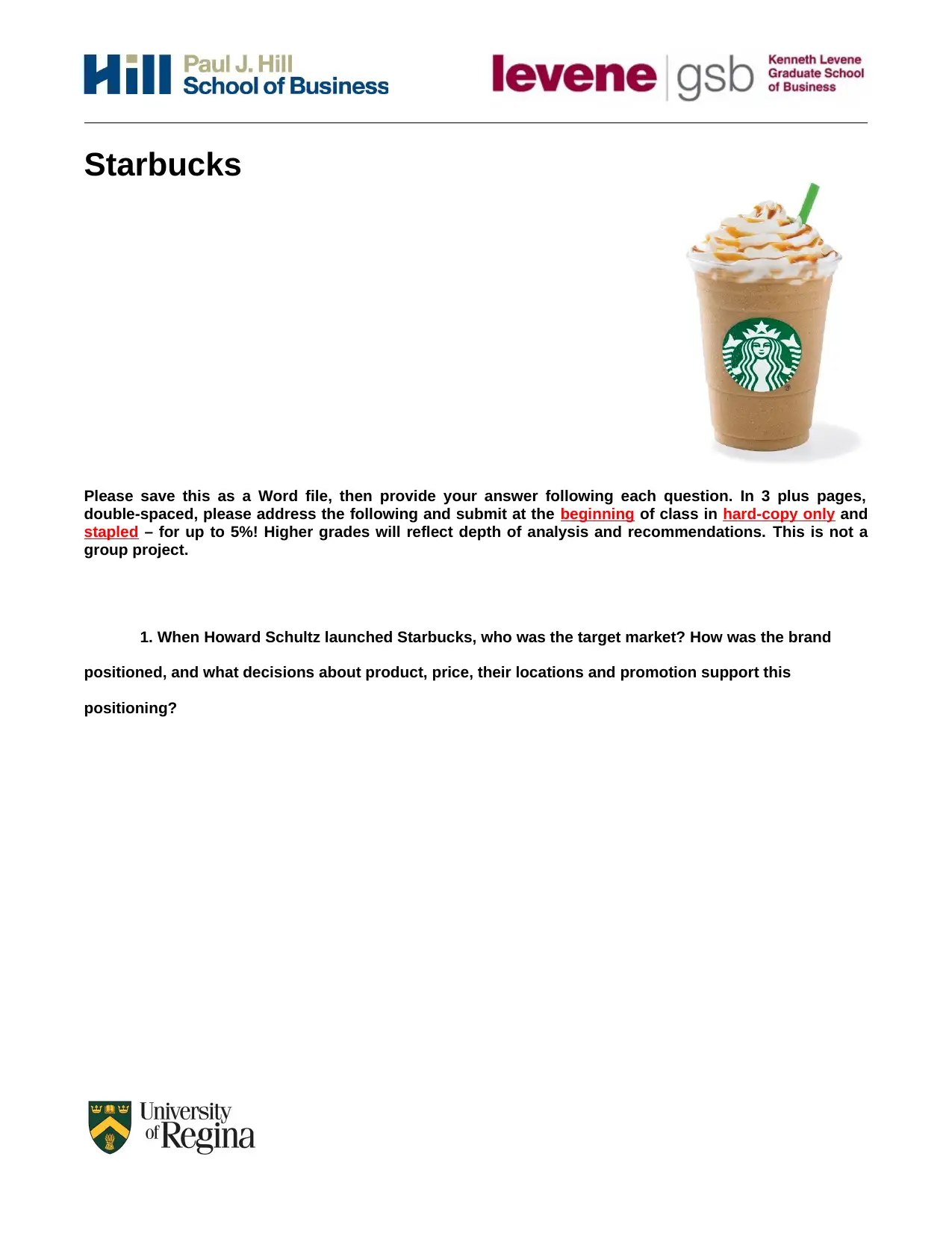
Starbucks
Please save this as a Word file, then provide your answer following each question. In 3 plus pages,
double-spaced, please address the following and submit at the beginning of class in hard-copy only and
stapled – for up to 5%! Higher grades will reflect depth of analysis and recommendations. This is not a
group project.
1. When Howard Schultz launched Starbucks, who was the target market? How was the brand
positioned, and what decisions about product, price, their locations and promotion support this
positioning?
Please save this as a Word file, then provide your answer following each question. In 3 plus pages,
double-spaced, please address the following and submit at the beginning of class in hard-copy only and
stapled – for up to 5%! Higher grades will reflect depth of analysis and recommendations. This is not a
group project.
1. When Howard Schultz launched Starbucks, who was the target market? How was the brand
positioned, and what decisions about product, price, their locations and promotion support this
positioning?
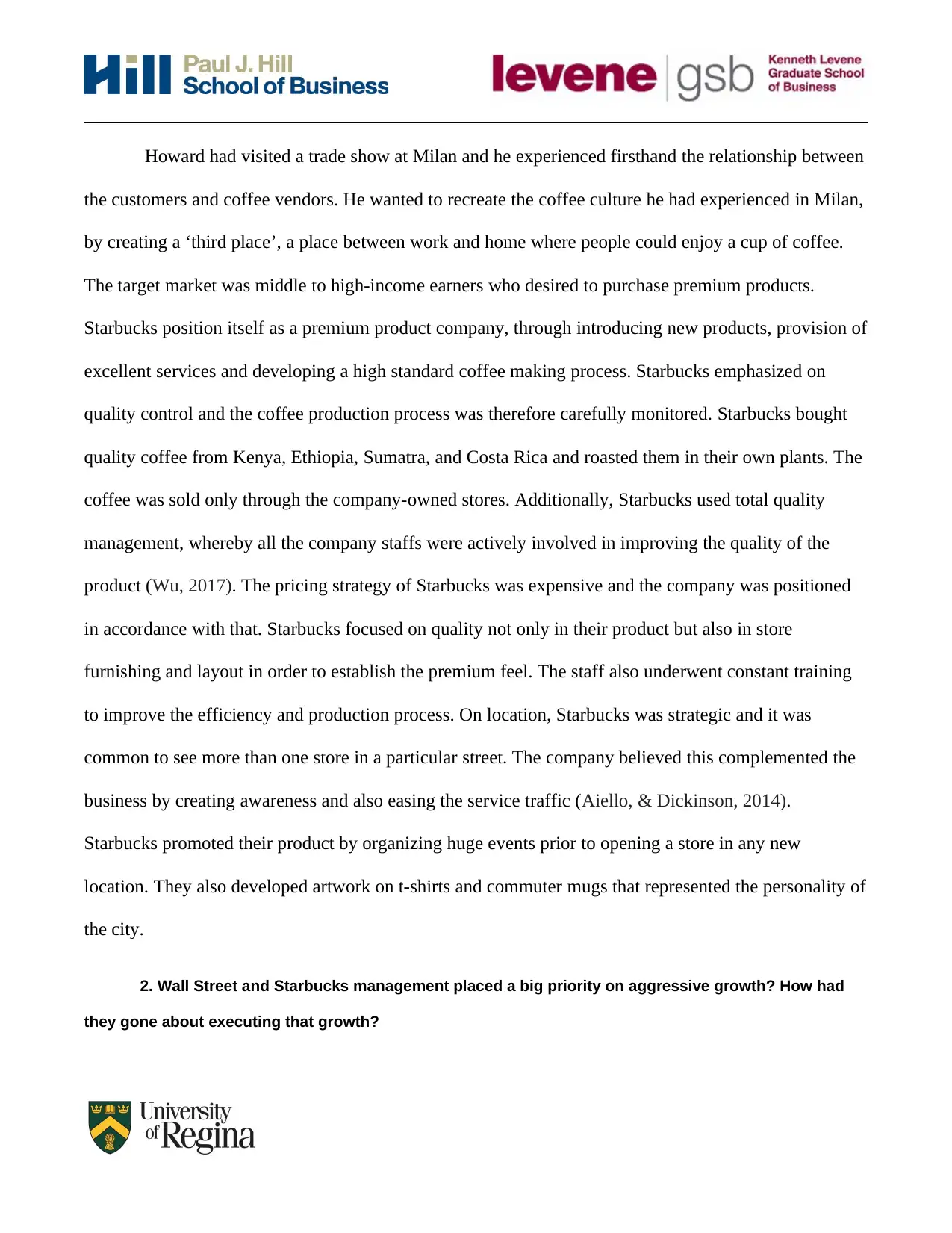
Howard had visited a trade show at Milan and he experienced firsthand the relationship between
the customers and coffee vendors. He wanted to recreate the coffee culture he had experienced in Milan,
by creating a ‘third place’, a place between work and home where people could enjoy a cup of coffee.
The target market was middle to high-income earners who desired to purchase premium products.
Starbucks position itself as a premium product company, through introducing new products, provision of
excellent services and developing a high standard coffee making process. Starbucks emphasized on
quality control and the coffee production process was therefore carefully monitored. Starbucks bought
quality coffee from Kenya, Ethiopia, Sumatra, and Costa Rica and roasted them in their own plants. The
coffee was sold only through the company-owned stores. Additionally, Starbucks used total quality
management, whereby all the company staffs were actively involved in improving the quality of the
product (Wu, 2017). The pricing strategy of Starbucks was expensive and the company was positioned
in accordance with that. Starbucks focused on quality not only in their product but also in store
furnishing and layout in order to establish the premium feel. The staff also underwent constant training
to improve the efficiency and production process. On location, Starbucks was strategic and it was
common to see more than one store in a particular street. The company believed this complemented the
business by creating awareness and also easing the service traffic (Aiello, & Dickinson, 2014).
Starbucks promoted their product by organizing huge events prior to opening a store in any new
location. They also developed artwork on t-shirts and commuter mugs that represented the personality of
the city.
2. Wall Street and Starbucks management placed a big priority on aggressive growth? How had
they gone about executing that growth?
the customers and coffee vendors. He wanted to recreate the coffee culture he had experienced in Milan,
by creating a ‘third place’, a place between work and home where people could enjoy a cup of coffee.
The target market was middle to high-income earners who desired to purchase premium products.
Starbucks position itself as a premium product company, through introducing new products, provision of
excellent services and developing a high standard coffee making process. Starbucks emphasized on
quality control and the coffee production process was therefore carefully monitored. Starbucks bought
quality coffee from Kenya, Ethiopia, Sumatra, and Costa Rica and roasted them in their own plants. The
coffee was sold only through the company-owned stores. Additionally, Starbucks used total quality
management, whereby all the company staffs were actively involved in improving the quality of the
product (Wu, 2017). The pricing strategy of Starbucks was expensive and the company was positioned
in accordance with that. Starbucks focused on quality not only in their product but also in store
furnishing and layout in order to establish the premium feel. The staff also underwent constant training
to improve the efficiency and production process. On location, Starbucks was strategic and it was
common to see more than one store in a particular street. The company believed this complemented the
business by creating awareness and also easing the service traffic (Aiello, & Dickinson, 2014).
Starbucks promoted their product by organizing huge events prior to opening a store in any new
location. They also developed artwork on t-shirts and commuter mugs that represented the personality of
the city.
2. Wall Street and Starbucks management placed a big priority on aggressive growth? How had
they gone about executing that growth?
⊘ This is a preview!⊘
Do you want full access?
Subscribe today to unlock all pages.

Trusted by 1+ million students worldwide
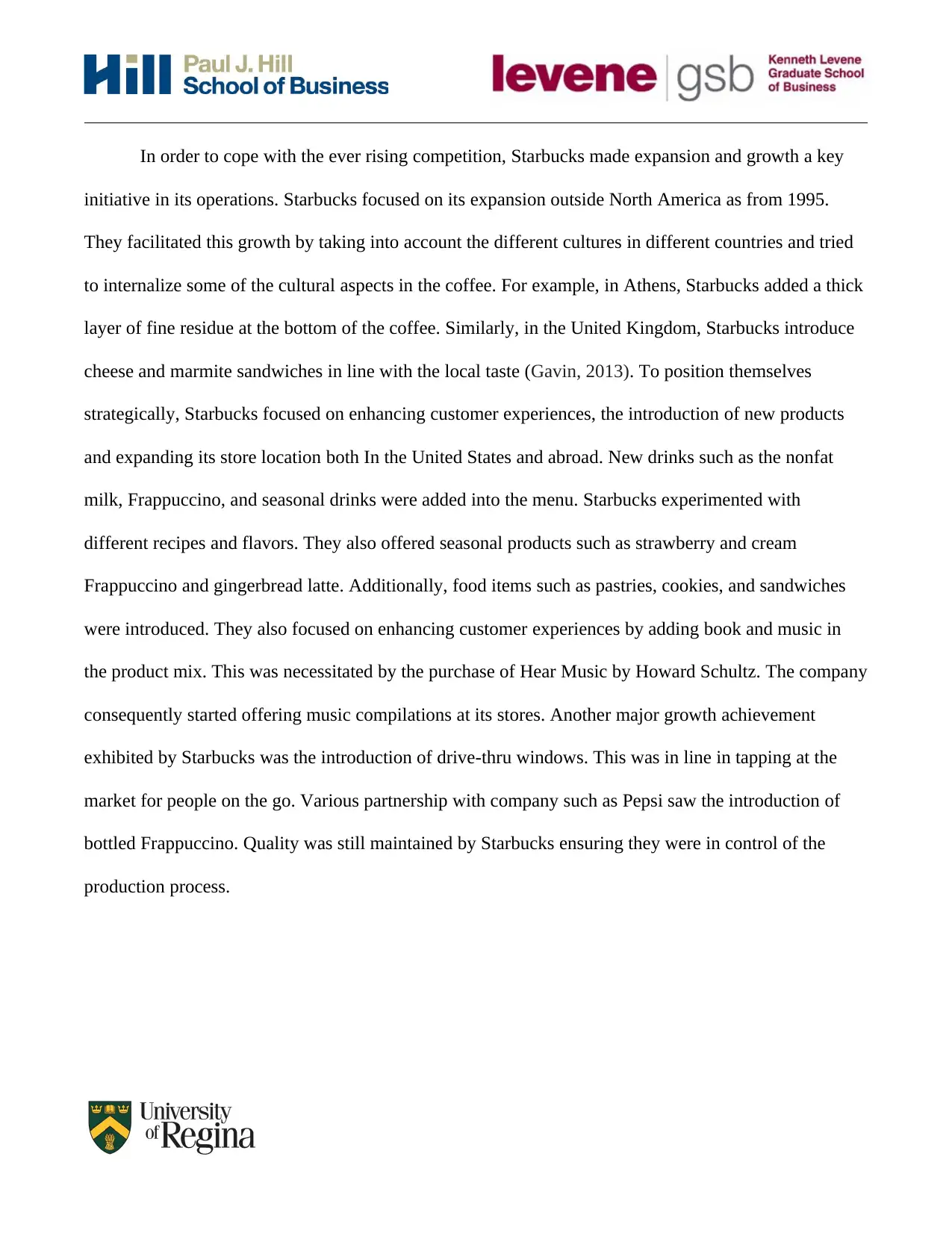
In order to cope with the ever rising competition, Starbucks made expansion and growth a key
initiative in its operations. Starbucks focused on its expansion outside North America as from 1995.
They facilitated this growth by taking into account the different cultures in different countries and tried
to internalize some of the cultural aspects in the coffee. For example, in Athens, Starbucks added a thick
layer of fine residue at the bottom of the coffee. Similarly, in the United Kingdom, Starbucks introduce
cheese and marmite sandwiches in line with the local taste (Gavin, 2013). To position themselves
strategically, Starbucks focused on enhancing customer experiences, the introduction of new products
and expanding its store location both In the United States and abroad. New drinks such as the nonfat
milk, Frappuccino, and seasonal drinks were added into the menu. Starbucks experimented with
different recipes and flavors. They also offered seasonal products such as strawberry and cream
Frappuccino and gingerbread latte. Additionally, food items such as pastries, cookies, and sandwiches
were introduced. They also focused on enhancing customer experiences by adding book and music in
the product mix. This was necessitated by the purchase of Hear Music by Howard Schultz. The company
consequently started offering music compilations at its stores. Another major growth achievement
exhibited by Starbucks was the introduction of drive-thru windows. This was in line in tapping at the
market for people on the go. Various partnership with company such as Pepsi saw the introduction of
bottled Frappuccino. Quality was still maintained by Starbucks ensuring they were in control of the
production process.
initiative in its operations. Starbucks focused on its expansion outside North America as from 1995.
They facilitated this growth by taking into account the different cultures in different countries and tried
to internalize some of the cultural aspects in the coffee. For example, in Athens, Starbucks added a thick
layer of fine residue at the bottom of the coffee. Similarly, in the United Kingdom, Starbucks introduce
cheese and marmite sandwiches in line with the local taste (Gavin, 2013). To position themselves
strategically, Starbucks focused on enhancing customer experiences, the introduction of new products
and expanding its store location both In the United States and abroad. New drinks such as the nonfat
milk, Frappuccino, and seasonal drinks were added into the menu. Starbucks experimented with
different recipes and flavors. They also offered seasonal products such as strawberry and cream
Frappuccino and gingerbread latte. Additionally, food items such as pastries, cookies, and sandwiches
were introduced. They also focused on enhancing customer experiences by adding book and music in
the product mix. This was necessitated by the purchase of Hear Music by Howard Schultz. The company
consequently started offering music compilations at its stores. Another major growth achievement
exhibited by Starbucks was the introduction of drive-thru windows. This was in line in tapping at the
market for people on the go. Various partnership with company such as Pepsi saw the introduction of
bottled Frappuccino. Quality was still maintained by Starbucks ensuring they were in control of the
production process.
Paraphrase This Document
Need a fresh take? Get an instant paraphrase of this document with our AI Paraphraser
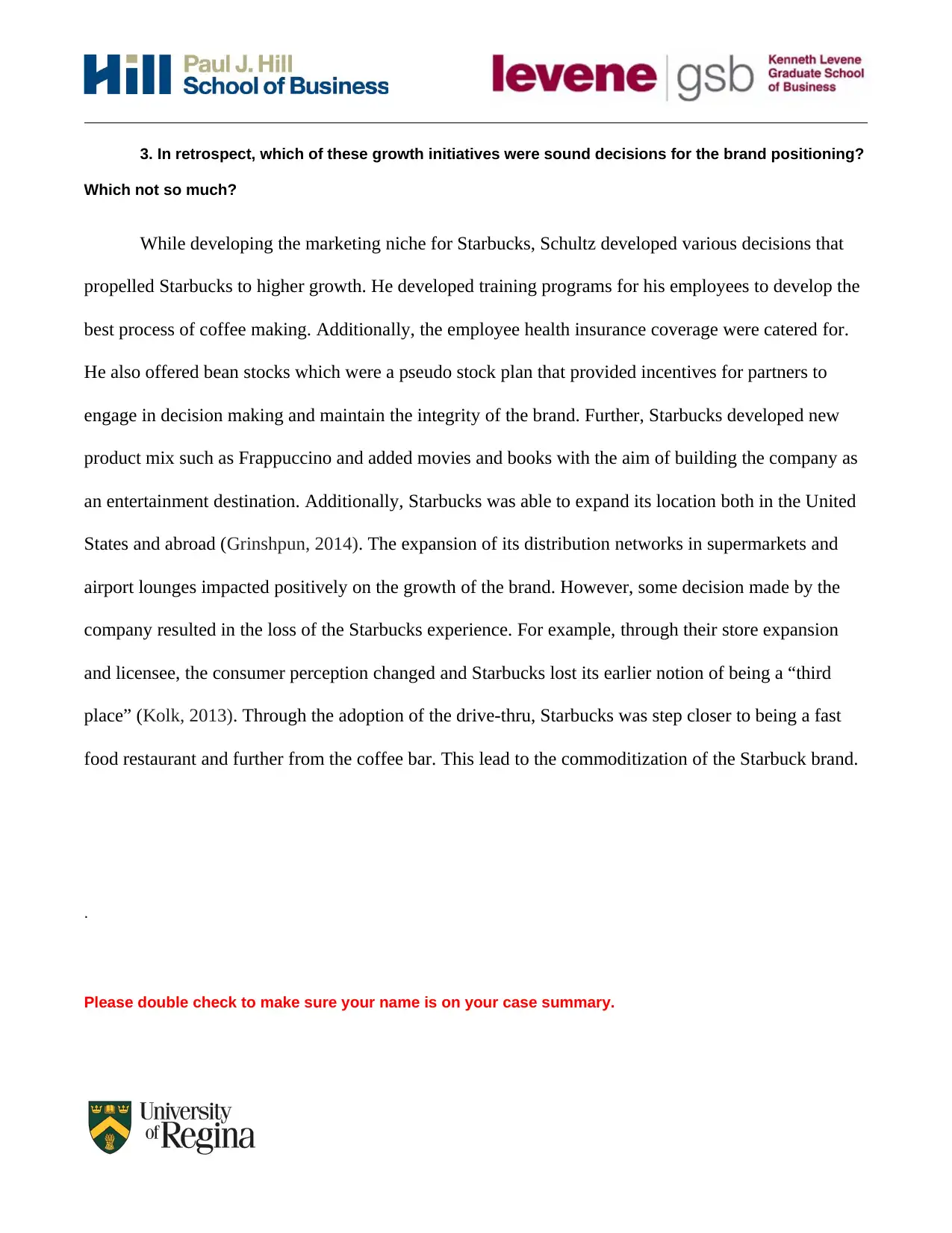
3. In retrospect, which of these growth initiatives were sound decisions for the brand positioning?
Which not so much?
While developing the marketing niche for Starbucks, Schultz developed various decisions that
propelled Starbucks to higher growth. He developed training programs for his employees to develop the
best process of coffee making. Additionally, the employee health insurance coverage were catered for.
He also offered bean stocks which were a pseudo stock plan that provided incentives for partners to
engage in decision making and maintain the integrity of the brand. Further, Starbucks developed new
product mix such as Frappuccino and added movies and books with the aim of building the company as
an entertainment destination. Additionally, Starbucks was able to expand its location both in the United
States and abroad (Grinshpun, 2014). The expansion of its distribution networks in supermarkets and
airport lounges impacted positively on the growth of the brand. However, some decision made by the
company resulted in the loss of the Starbucks experience. For example, through their store expansion
and licensee, the consumer perception changed and Starbucks lost its earlier notion of being a “third
place” (Kolk, 2013). Through the adoption of the drive-thru, Starbucks was step closer to being a fast
food restaurant and further from the coffee bar. This lead to the commoditization of the Starbuck brand.
.
Please double check to make sure your name is on your case summary.
Which not so much?
While developing the marketing niche for Starbucks, Schultz developed various decisions that
propelled Starbucks to higher growth. He developed training programs for his employees to develop the
best process of coffee making. Additionally, the employee health insurance coverage were catered for.
He also offered bean stocks which were a pseudo stock plan that provided incentives for partners to
engage in decision making and maintain the integrity of the brand. Further, Starbucks developed new
product mix such as Frappuccino and added movies and books with the aim of building the company as
an entertainment destination. Additionally, Starbucks was able to expand its location both in the United
States and abroad (Grinshpun, 2014). The expansion of its distribution networks in supermarkets and
airport lounges impacted positively on the growth of the brand. However, some decision made by the
company resulted in the loss of the Starbucks experience. For example, through their store expansion
and licensee, the consumer perception changed and Starbucks lost its earlier notion of being a “third
place” (Kolk, 2013). Through the adoption of the drive-thru, Starbucks was step closer to being a fast
food restaurant and further from the coffee bar. This lead to the commoditization of the Starbuck brand.
.
Please double check to make sure your name is on your case summary.
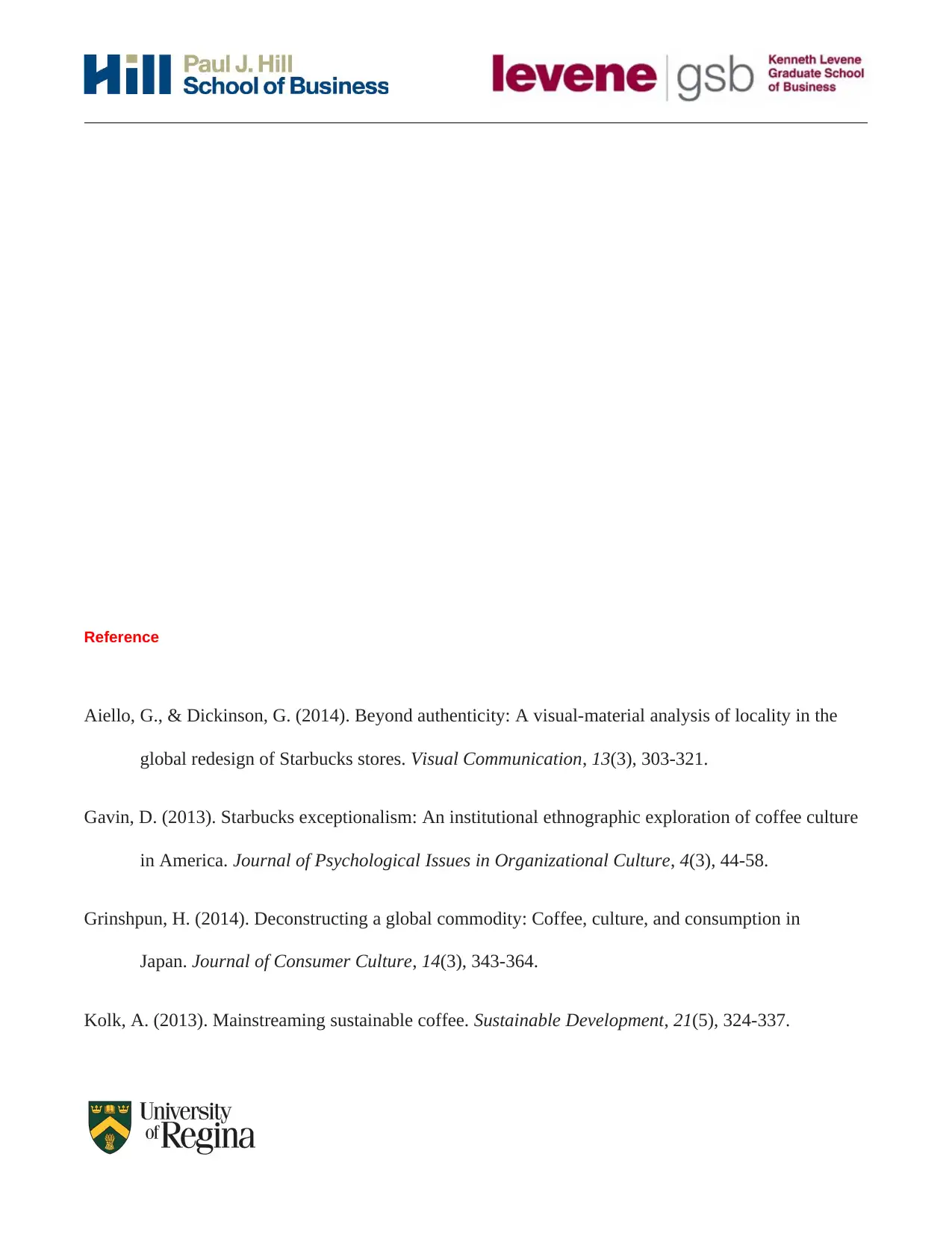
Reference
Aiello, G., & Dickinson, G. (2014). Beyond authenticity: A visual-material analysis of locality in the
global redesign of Starbucks stores. Visual Communication, 13(3), 303-321.
Gavin, D. (2013). Starbucks exceptionalism: An institutional ethnographic exploration of coffee culture
in America. Journal of Psychological Issues in Organizational Culture, 4(3), 44-58.
Grinshpun, H. (2014). Deconstructing a global commodity: Coffee, culture, and consumption in
Japan. Journal of Consumer Culture, 14(3), 343-364.
Kolk, A. (2013). Mainstreaming sustainable coffee. Sustainable Development, 21(5), 324-337.
Aiello, G., & Dickinson, G. (2014). Beyond authenticity: A visual-material analysis of locality in the
global redesign of Starbucks stores. Visual Communication, 13(3), 303-321.
Gavin, D. (2013). Starbucks exceptionalism: An institutional ethnographic exploration of coffee culture
in America. Journal of Psychological Issues in Organizational Culture, 4(3), 44-58.
Grinshpun, H. (2014). Deconstructing a global commodity: Coffee, culture, and consumption in
Japan. Journal of Consumer Culture, 14(3), 343-364.
Kolk, A. (2013). Mainstreaming sustainable coffee. Sustainable Development, 21(5), 324-337.
⊘ This is a preview!⊘
Do you want full access?
Subscribe today to unlock all pages.

Trusted by 1+ million students worldwide
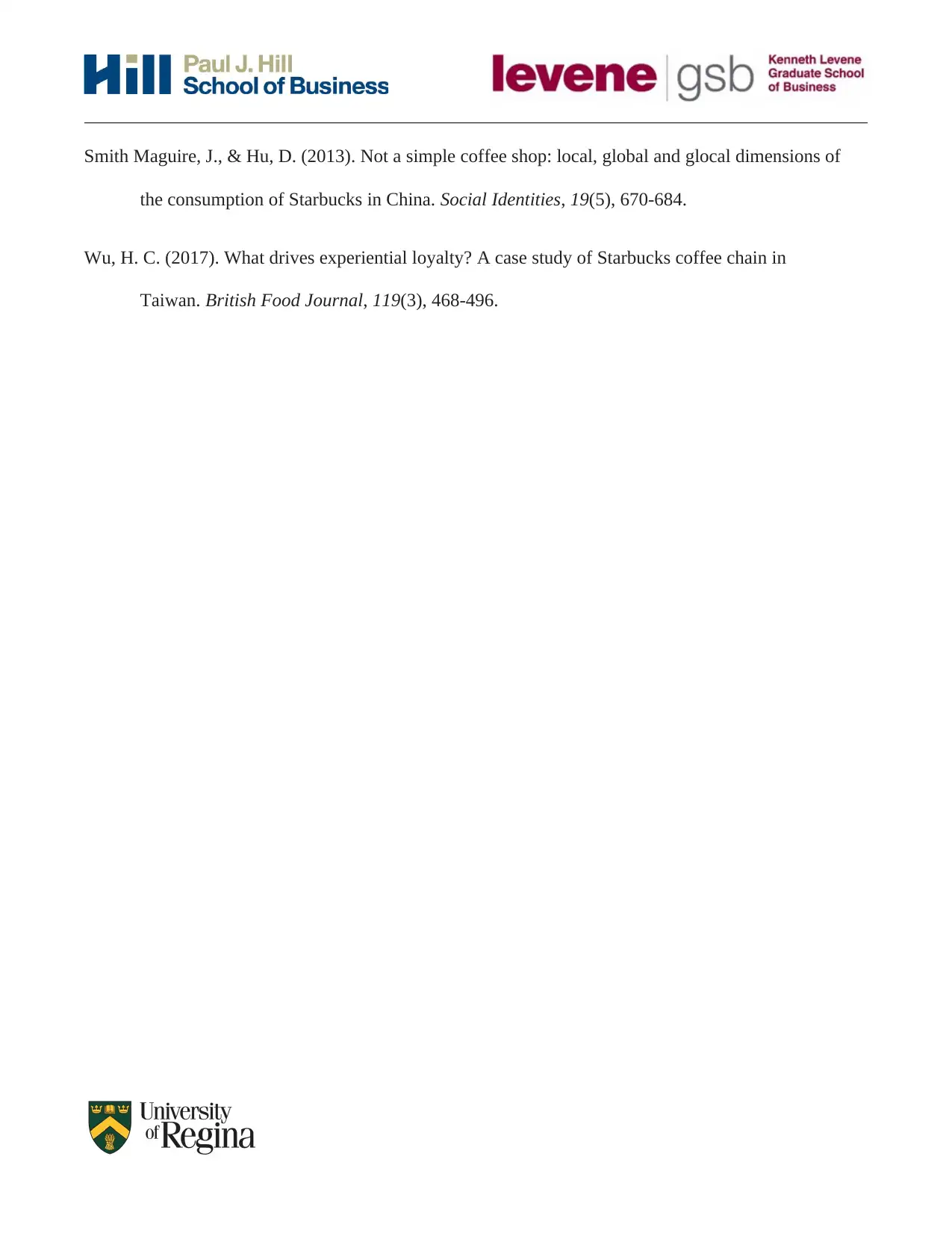
Smith Maguire, J., & Hu, D. (2013). Not a simple coffee shop: local, global and glocal dimensions of
the consumption of Starbucks in China. Social Identities, 19(5), 670-684.
Wu, H. C. (2017). What drives experiential loyalty? A case study of Starbucks coffee chain in
Taiwan. British Food Journal, 119(3), 468-496.
the consumption of Starbucks in China. Social Identities, 19(5), 670-684.
Wu, H. C. (2017). What drives experiential loyalty? A case study of Starbucks coffee chain in
Taiwan. British Food Journal, 119(3), 468-496.
1 out of 7
Related Documents
Your All-in-One AI-Powered Toolkit for Academic Success.
+13062052269
info@desklib.com
Available 24*7 on WhatsApp / Email
![[object Object]](/_next/static/media/star-bottom.7253800d.svg)
Unlock your academic potential
Copyright © 2020–2025 A2Z Services. All Rights Reserved. Developed and managed by ZUCOL.





